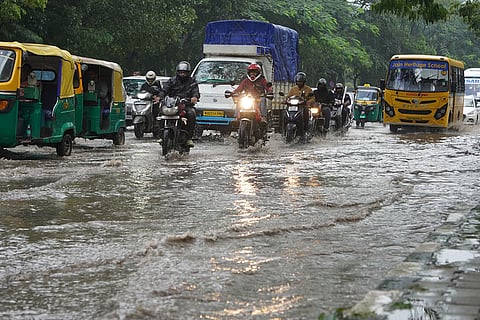

The monsoon has just made landfall and is creeping across the peninsula. However, flooding in urban India arrived with pre-monsoon showers this year—as a reminder of the nightmares that follow every year. The spectacle is vividly visible across India’s cities, from Mumbai to Guwahati and Bengaluru to Gurugram.
Urban India hosts around 150 Lok Sabha constituencies and is home to nearly 550 million citizens—one in three in a 1.4-billion population. Cities occupy 3 percent of the land area and contribute over 60 percent of the GDP. They are critical enablers of economic dynamism—be it production or consumption of goods, provision of services and a large share of employment. Urban India also contributes the bulk of taxes—be it indirect taxes in the form of GST or in income tax receipts.
Yet, urban India faces a flood of woes and a drought of action. Take Bengaluru, India’s ‘Silicon Valley’, and destination for the bulk of venture capital. Floods brought it to a halt following 10 cm of rains. Access to IT parks and technology companies were water-logged, triggering work-from-home directives. Anger spilled over on social media, saturated by commentary and photographs of boats and dumpers deployed to rescue people and cars stranded in basements. As a result, typically, the government is banning parking in basements.
In India’s business capital Mumbai, the Andheri subway, a benchmark for flooding in the western suburbs, was shut down. In south Mumbai, the systemic sloth afflicting the city was symbolised by the flooding at Bora Bazar, where the contractors ‘forgot’ to provide for drainage. In Smart City Pune—a start-up hub and a destination for global capability centres—access to new habitats in the IT corridor and near the airport were flooded following an hour of rains. Yes, this has been the wettest summer since 2015; but the cumulative rainfall was under 12 cm for the May 1-21 period.
Take the national capital Delhi, which is governed by three layers of the same party. Earlier this month, several parts of Delhi—including Connaught Place, Sadar Bazar and Kamala Nagar—were waterlogged after a few hours of showers. Despite assurances, lives and livelihoods in areas such as Azad Market and the infamous Minto Road underpass were under water. In neighbouring Gurugram, homes costing crores of rupees found sewer water entering their basements. Unsurprisingly, urban India is gripped every year by a sense of déjà vu and frustrating anger.
Urban development in the Indian context is, effectively, an unplanned amoebic expansion of housing and commercial spaces. The faultlines are documented. A 2021 report of the ministry of housing and urban affairs observes, “Floodplains in Indian cities are very much exposed to unauthorised construction, which has taken place without preparation and approval of layout plans.” Flooding is a result of poor retrofitting of policy and facilities such as drainage. Add to this the inadequacies of waste management, poor desilting, the inefficiencies haunting urban local bodies and lack of capacity.
In 2014, the BJP manifesto promised the construction of 100 new cities. That was replaced with a promise of Smart Cities launched in June 2015. The mission: to promote cities that provide core infrastructure, clean and sustainable environment, and give a decent quality of life to their citizens through the application of ‘smart solutions’. How has that panned out? The Smart Cities Mission (SCM) covered 100 cities. As per data provided in parliament, 8,063 projects costing over Rs 1,64,545 crore were taken up, and 7,504 projects costing over Rs 1,50,306 crore were completed. It is arguable that this spend should have included provision of infrastructure to prevent flooding. But cities continue to be flooded.
The SCM was supplemented by another scheme called AMRUT, launched in 2015 to cover 500 cities and towns. The mission: development of basic infrastructure. The thrust areas: water supply, sewage and septage management, storm-water drains to reduce flooding, besides public transport and enhancement of amenities. Under AMRUT, over 6,000 projects worth Rs 83,578 crore were taken up.
What was the spending on flood prevention and what has it delivered? Some 793 projects with a total spend Rs 2,332 crore for 1,434 km of storm water drains were taken up. The where-what of their success is as fuzzy as the answer provided in the Lok Sabha. The gap between need and delivery is stark. A 2022 World Bank report estimates that India would need to spend as much as $840 billion in 15 years on its urban infrastructure to meet the needs of a growing urban population that’s expected to touch 600 million by 2036.
The hurdle is not only of resources—the government’s total expenditure in the decade since 2014 has gone up from Rs 17.94 lakh crore to Rs 50.65 lakh crore, as the GDP more than doubled. The situation is worsened by a poverty of political intent. The architecture of governance disempowers urban governance. The promise of the 74th Amendment to the Constitution—transfer of funds and functions from the Centre and states to local governments—was reduced to legalese in over a quarter of a century. Local bodies are colonised by states, just as states are colonised by the Union.
Urbanisation is a proven force-multiplier of employment, incomes and growth. Unfortunately, the architecture of politics, with an inherent bias for freebie-funded votes, has reduced urban India into a constituency of a lesser god.
Author of The Gated Republic, Aadhaar:
A Biometric History of India’s 12 Digit
Revolution, and Accidental India
(shankkar.aiyar@gmail.com)